The Mandalorian is a show that rarely wants to sit in its worldbuilding. Things are said, they are present in the moment they need to be, and then it moves on to the next thing, like its wandering mercenary hero. But this week it tried something different—taking a leaf out of the book of its Star Wars streaming contemporary, Andor.
- Off
- English

“The Convert,” the third episode of The Mandalorian’s third season, largely keeps away from the story of Din Djarin and Bo-Katan Kryze, outside of book-ended scenes where we learn that Din, unlike Bo, didn’t catch a glimpse of the legendary Mythosaur when he was dragged under the waters of Mandalore’s mines last week. After a return to Kalevala is cut short by an attack from Imperial raiders that destroys Katan’s castle, the duo return to Din’s covert—where the Armorer conducts both he and Bo into the clan. These moments are brief, but reflect a wider issue with “The Convert” that becomes much clearer when it’s tackling the far more interesting main plot: events occurring at the heart of the New Republic, on Coruscant itself.
Advertisement
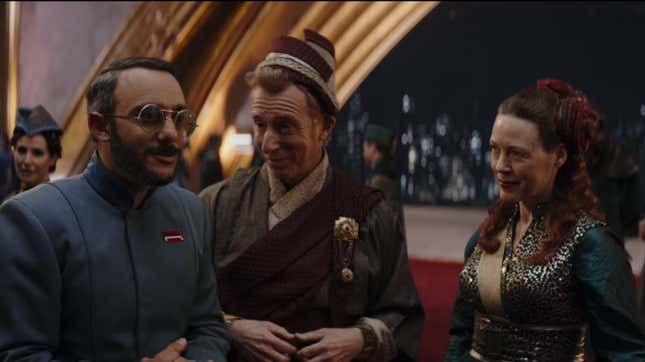
The main character of “The Convert” is not a Mandalorian, but a different kind of convert altogether—Omid Abtahi’s Dr. Pershing, the former Imperial scientist working with the Client and then Moff Gideon to explore cloning and the Force powers of the young Grogu. It turns out that after Moff Gideon was rendered into New Republic custody, Pershing entered a sort of Star Wars equivalent to Operation Paperclip (the post-WWII drive by the U.S. government to recruit Nazi scientists to work on its own projects in exchange for lenience), an amnesty program that takes Imperial operatives, gives them just the mildest smidge of brainwashing, and helps rehabilitate them into the neoliberal dream: a chance to work in a position of ineffective bureaucracy.
G/O Media may get a commission
Advertisement
Whether or not The Mandalorian fully grasps just how horrifying its vision of the New Republic is, is entirely unsure by the end of “The Convert,” but it certainly spends a fascinatingly great deal of time giving the audience the evidence to prove it, even if the characters within this story don’t actually directly question it. From an opening speech where Pershing exalts his lament for working with the Empire, to an audience of nobles who casually, jokingly comment that they’re so far removed from the events of the galaxy that they have not actively noticed if the Empire or the New Republic is in charge, we are primed to see the galactic core’s new status quo as little more than a nicer veneer on the same old evils.
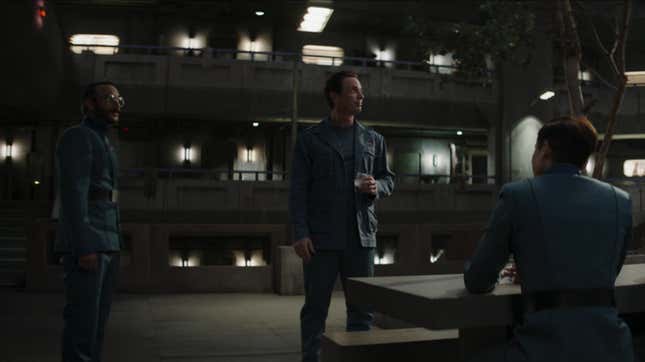
Advertisement
Pershing and his fellow amnesty applicants (which, surprisingly, also includes Katy O’Brian’s Imperial assistant to Moff Gideon from season two, named here for the first time as Elia Kane) are stripped of their humanity compared to the other denizens of Coruscant—they all wear identical uniforms with badges indicating their status, their names are replaced with an alphanumeric code, they all live in one section of stark, impersonal federal housing on the planet. Their regular check-ins with New Republic administrators are equally clinical—simple questions that are essentially “Do you feel like being an Imperial any more?”, stated by a droid that then shuffles them out to to go back to their pencil-pushing jobs. Jobs like Pershing’s, which isn’t scientific research like he longs to do but instead archive administration, filing paperwork to scrap Imperial technology being junked by the New Republic, regardless of its origins.
Pershing and his fellow amnesty applicants are, for the most part, incredibly happy with this situation. The audience is primed to see just how bleak it is that the New Republic is not the kind of radical organization is rebellious origins desired to restore—for all intents and purposes, it is the same status quo for the powerful with some nicer branding—but Pershing, Kane, and the other ex-Imperials all seem largely satisfied with their new circumstances. But Kane begins to push Pershing more and more to think about what he wants to do to help the New Republic, because his talents as a scientist are wasted being trapped at a desk logging archives. As the two become more and more friendly, taking in the sights and lavish spectacle of the New Republic’s thin veneer of peace—bright lights, public fetes complete with a chintzy elevator muzak rendition of what will become the “March of the Resistance” in the sequel movies—Kane slowly convinces Pershing that the lab gear he is archiving for destruction should instead be used by him to continue his work. Pershing readily agrees, not from an Imperial standpoint, but by being seemingly so brought into the New Republic that he wants to do what any good citizen would, even if it’s against the new rules imposed upon him.
Advertisement
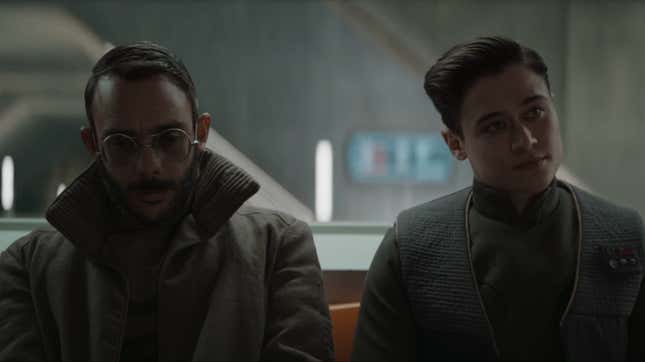
When the duo sneak into the hull of an Imperial Star Destroyer marked for scrapping to swipe some of the tech Pershing would need to continue his research, however, things take a twist—as New Republic officers and ships circle the duo, it’s revealed Kane is an informant for her new masters, someone designed to push and root out potential Imperial sentiment among the amnesty applicants in exchange for a higher position herself. Even as Pershing persists that all he wants to do is help, he’s whisked away for a round of what we mentioned earlier, and arguably the closest The Mandalorian’s view of the New Republic comes to having some real bite: the mild brainwashing.
Advertisement
Said brainwashing is done with what a New Republic lab tech cheerily tells an anxious Pershing is a “602 Mitigator,” but Pershing knows it by its real name: an Imperial Mind Flayer, a torture device capable of extreme and brutal pain and memory wiping. The New Republic has given it a literal and metaphorical coat of paint, it seems, and had found that at low voltages the Mind Flayer can de- and re-program dissidents with selective memory alteration. “This isn’t the Empire, son,” the Mon Calamari tech tells Pershing. “This device is used to heal,” before he inadvertently laces his reassurance with a chilling bit of context: “I’ve been through the treatment myself in fact, and found the experience quite refreshing.”
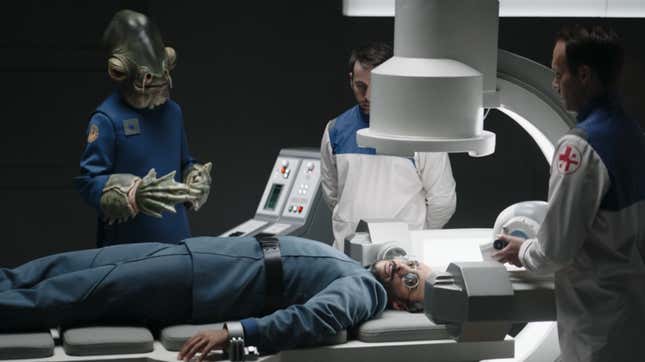
Advertisement
Were The Mandalorian closer to the elements of Andor’s political critiques that feel paralleled here, this moment would be the coup de grace in a devastating examination of the faction we as Star Wars fans are meant to see as the heroes of the piece. Pershing is, regardless of his prior connections and intents, unequivocally presented as a good person being abused by a horrifying, controlling system, and the system is the people who blew up the Death Stars and defeated the Empire in the Star Wars movies. It is a chance for the show to take Star Wars’ fondness for cyclical storytelling—where there is always an Empire, and always a resistance to rise up against it—and examines what it means that, given power, its rebels become the very thing they swore to destroy with more effective PR. But just as it is about to stop talking around the thematic elephant in the room, and really engage with it, the moment is punctured.
It turns out the New Republic’s rebrand of the Mind Flayer still conveniently kept the full dial that can take it from relaxing brainwashing to a full on brain scrambling. And Kane is not just a New Republic informant, but still seemingly loyal to Moff Gideon and the Remnant: trusted to be left alone, she gleefully snacks on one of the Imperial ration biscuits she first tempted Pershing with when they re-encountered each other in asylum as she cranks the dial all the way up—and while we don’t see the outcome in full, it’s clear from Pershing’s pained expressions that it’s not going to be exactly good. But this twist upon a twist with Kane undercuts almost everything else the episode was politically navigating in fleshing out our still-nascent understanding of how the New Republic operated in this version of Star Wars continuity. The Imperials built the Mind Flayer, the New Republic kept using it, but it was secretly an Imperial all along that cranked that dial up to brain-melt. Because they’re the bad guys! Not the people who decided to keep the torture devices to control defectors as they’re ghettoized but in the “proper” way.
Advertisement
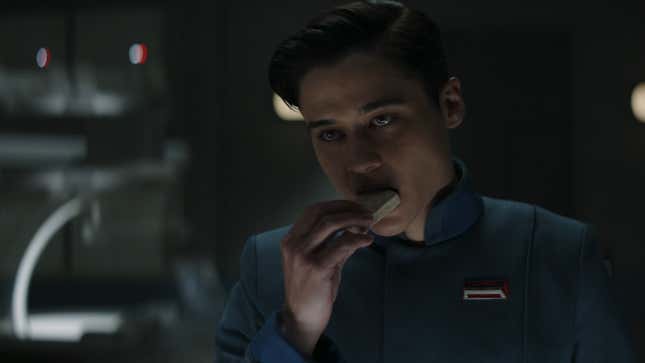
In keeping its critical view of the New Republic largely unspoken, and making this twist so textually loud in comparison, The Mandalorian runs into the problem of asking questions but never being bold enough to consider answering them, no matter how uncomfortable the question in the first place. It’s the same when the episode concludes by returning to Din and Bo’s story—the Armorer re-embraces them both as what she considers to be Mandalorian in her eyes, the one “Way” for their people, but neither character questions her worldview and what exactly they have supposed perverted by going against its theological tenets. They’re just welcoming into the club like nothing’s happened, and that’s that, on to the next thing.
Advertisement
But this is a problem the show has long struggled with. Time and time again The Mandalorian will raise an interesting question—how does Din grapple with the knowledge that he was raised by a group that rose out of a terrorist faction? What will it mean for him to spend time without the child he had grown to care for as a father? What does it mean for him to have learned that Mandalore is not like the stories he was told? How does Bo-Katan feel about literally anything at any time that isn’t awkwardly sitting on her now-exploded throne?—and feel like it has done the necessary work by asking it, so it promptly moves on to the next question. Rarely does it ever sit with what should be big moments for its characters and its story, because the next thing or the next character is always on the horizon, and the show constantly loses its sense of object permanence for the narrative.
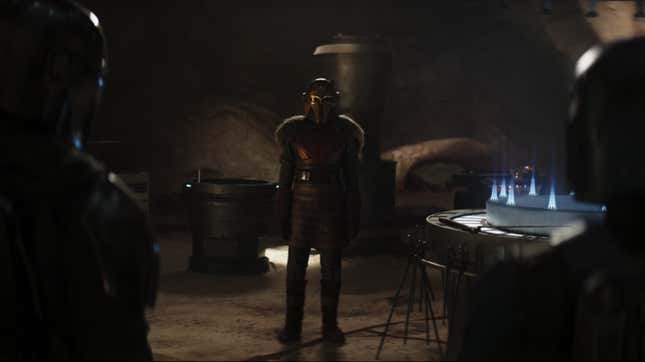
Advertisement
That in part works for a show that started out as something that operated, literally and metaphorically, on the outer rim of Star Wars storytelling, where it excelled on emphasizing tone over individual plot points and narrative commentary. But with the beast The Mandalorian has become—arguably the most important piece of Star Wars to exist in this moment, the lens through which the franchise’s future is carved out—that kind of vibes-based approach to its world and its characters has reached something of an endpoint in season three, especially if we’re going to start seeing episodes like this that pull us away from Din and Grogu’s increasingly expanding orbit to examine the state of the wider galaxy in this moment. It’s good that the show raises these questions, but it needs to start looking beyond questioning and come to some sort of answer for what it wants to say about its world, and its heroes and villains alike.
Want more io9 news? Check out when to expect the latest Marvel, Star Wars, and Star Trek releases, what’s next for the DC Universe on film and TV, and everything you need to know about the future of Doctor Who.
Services Marketplace – Listings, Bookings & Reviews